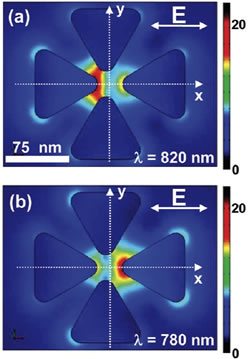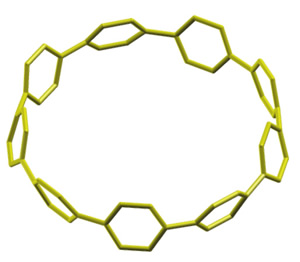The Molecular Foundry – Chemistry on the Nanoscale
By Lynn Yarris

The six-story, 96,000 square-foot building that houses Berkeley Lab’s Molecular Foundry won a U.S. Green Building Council Leadership in Energy and Environmental Design (LEED) gold certification, the first LEED gold certification ever awarded to a building in the City of Berkeley.
The chemistry that takes place in biological systems is proof that chemistry on the nanoscale can deliver spectacular results. Biological systems use nanoscale chemistry to transform and store energy, perform self-repair, and adapt to changing environmental conditions. Learning to harness nanoscale chemistry as effectively as nature should open doors to advances in a great many scientific fields, including energy and information technologies. The study of the chemistry behind nanoscale materials and processing is part of the mission of Berkeley Lab’s Molecular Foundry.
The Moleculary Foundry is one of five U.S. Department of Energy (DOE) Nanoscale Science Research Centers and the only one on the West Coast. Housed inside its six-story, 96,000 square-foot steel, concrete and glass building, are the sophisticated instrumentation and other scientific resources required for the synthesis and characterization of nanoscale materials.
“The Molecular Foundry has nanoscale research capabilities not found at any other facility,” says Carolyn Bertozzi, a chemist who has directed the Foundry since its dedication in 2006. “It creates an environment in which scientists from different disciplines can work together under one roof to expand our knowledge of the nature of matter on a nanoscale.”
The Molecular Foundry serves as a hub for collaborations that, in addition to nanoscale chemistry, include fields such as materials science, biology, physics and engineering. The Foundry is organized into six interdependent research facilities: Imaging and Manipulation of Nanostructures; Nanofabrication; Inorganic Nanostructures; Organic and Macromolecular Synthesis; Biological Nanostructures; and Theory of Nanostructured Materials. In addition, the Molecular Foundry also serves as a portal into three other national user facilities at Berkeley Lab: the Advanced Light Source, an electron synchrotron that generates highly bright and intense x-rays and ultraviolet light; the National Center for Electron Microscopy, home to the world’s two most powerful transmission electron microscopes; and the National Energy Research Scientific Computing Center (NERSC), one of the nation’s most powerful computing resources for non-classified research.

Researchers at Berkeley Lab’s Molecular Foundry have created bowtie-shaped antennae that function as the first tunable nano “colorsorters.”
Internal research at the Molecular Foundry converges around four research themes that reflect the expertise of the Foundry’s staff: Combinatorial Nanoscience, in which robotic synthesizers are used to generate and test large libraries of biological and inorganic nanostructures for optical, electronic and thermal properties; Nanointerfaces, where mechanical and transport properties are engineered for hybrid nanomaterials; Multimodal in situ Nanoimaging, in which multiple imaging techniques are used to investigate dynamic nanoscale phenomena in liquid and vapor environments; and Single-digit Nanofabrication, where combinations of biological and organic templates, advanced lithographies and probe-based surface modifications are used to fabricate nanoscale structures, features and spaces that measure less than 10 nanometers.
At the time of its dedication, then Berkeley Lab Director Steven Chu, now the Secretary of Energy said, “The Molecular Foundry represents a concerted effort to bring together all that we have learned about nanoscale materials and properties.”
In just three years of operations, the Molecular Foundry has already garnered an impressive list of accomplishments. This past year alone, for example, researchers at the Foundry have found a better way to make carbon nanotubes, the workhorse of nanotechnology, and a better way of directing chemical modifications to specific sites on recombinant proteins, including the monoclonal antibodies that are so important in the pharmaceutical industry.

Researchers at Berkeley Lab’s Molecular Foundry have found a new way to make carbon nanotubes via a hoop-shaped chain of benzene molecules that yields a compound called cycloparaphenylene. This technique could usher in a new era of more efficient carbon nanotube production.
Researchers at the Foundry have also discovered a potential on-off switch for nanoelectronics – one simply pushes or pulls on a molecular junction; constructed a tailor-made artificial cell-signaling system, analogous to natural cell systems that communicate via growth factors; provided the first experimental demonstration of optical antimatter, the phenomenon in which light travels through a material without being distorted; produced non-toxic magnesium oxide nanocrystals that efficiently emit blue light and could also play a role in long-term storage of carbon dioxide; and created bowtie-shaped antennae that function as the first tunable nano “colorsorters,” able to capture, filter and steer light at the nanoscale.
The idea behind Berkeley Lab’s Molecular Foundry was originally conceived by Daniel Chemla, a Berkeley Lab physicist and leading authority on the optical and electronic properties of materials who died in 2008. Recalling that a traditional foundry is a place where objects can be made (from the term “founding,” pouring a liquid into a solid mold), Chemla proposed a new type of foundry where objects could be made at the molecular level. He envisioned this molecular-level foundry as a place that would “change the paradigm” for nanoscale chemistry and materials research. Berkeley Lab’s Molecular Foundry is well on its way to fulfilling Chemla’s dream.
Additional Information
- For more information about the Molecular Foundry, visit the Web at http://foundry.lbl.gov
- For more information on the research accomplishments mentioned in this article, visit the Berkeley Lab News Center at http://newscenter.lbl.gov/


